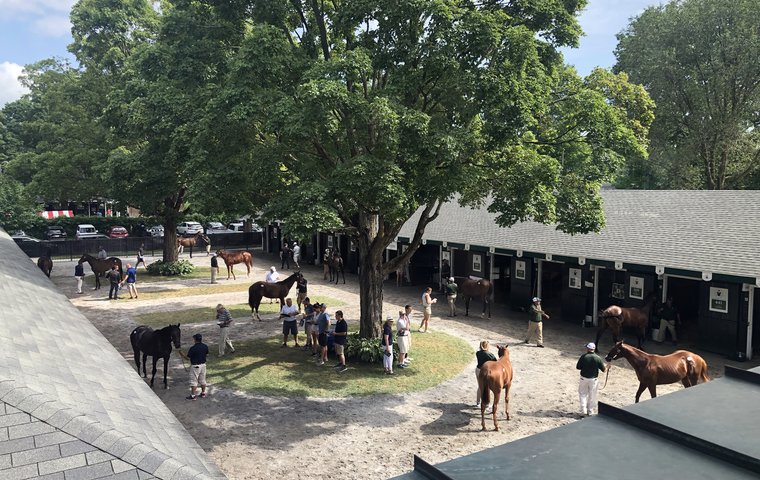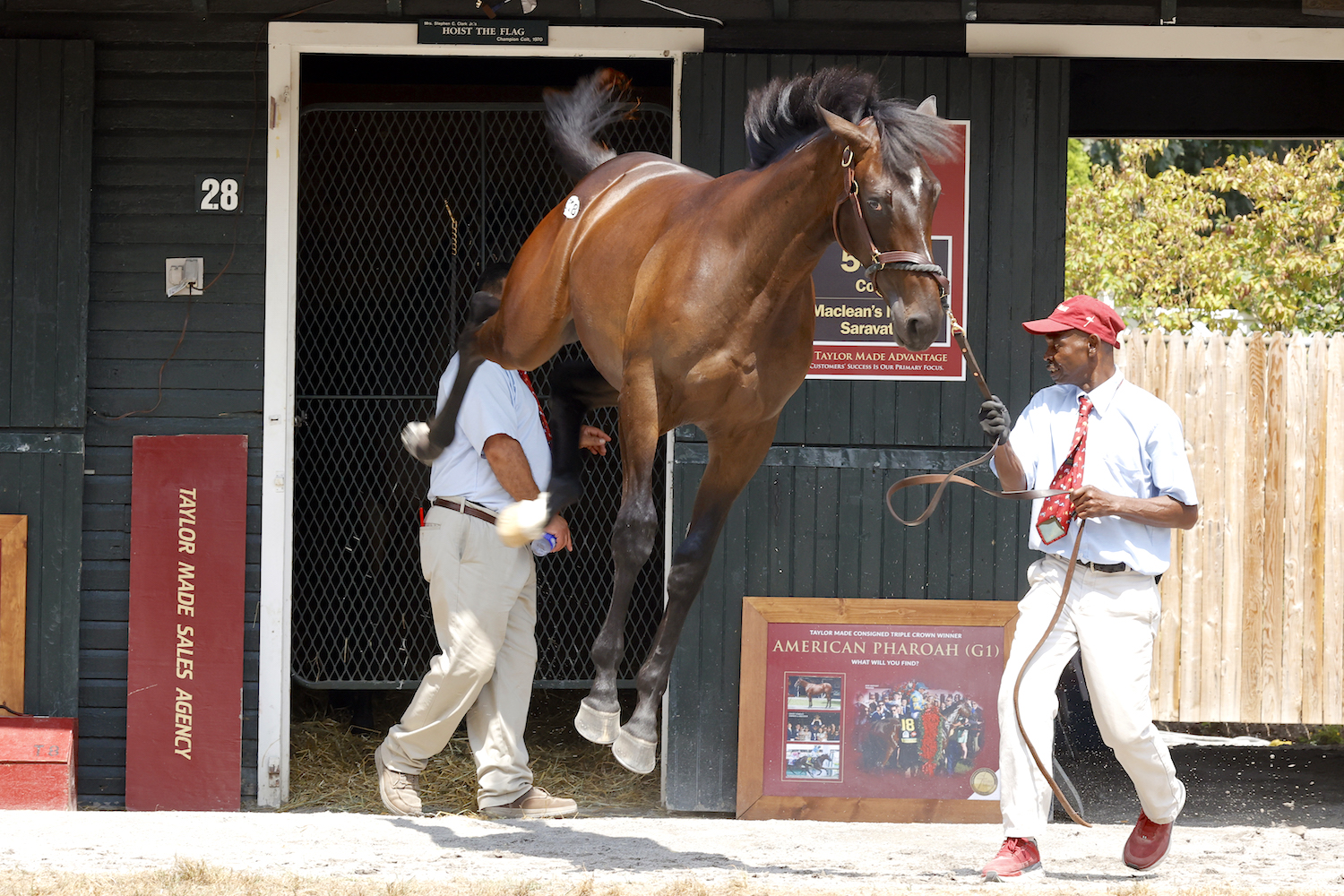
It can be hard to remember that really, they’re just babies. They’re big. They’re energetic. They’re muscled.
And while they are also very well trained — “professional” in industry parlance — they can’t always maintain their big girl/big boy poise, especially under the intense inspection and chaos that is an elite horse auction.
This year’s Fasig-Tipton Saratoga sales took place on August 9, 10, 15, and 16. Approximately 600 yearlings took up temporary residence at the sales grounds on East Avenue, across the street from both the Oklahoma training facility and Saratoga Race Course. They were scrutinized and scoped. They stood and they walked. Mostly, they kept themselves together, performing the first of many jobs they are likely to encounter in their lives, which can stretch to three decades.
Hip 186 stood with South Point Sales’ Justina Severni on the lawn outside of their consignment. As the lovely bay filly had draped her head and neck over Justina’s shoulder, Justina beckoned to me.
“Come here,” she said. “I want you to meet her.”
Sweet as a kitten, the daughter of Bolt d’Oro stretched her neck out, nuzzling the newcomer, practically sighing with contentment amid the outpouring of affection.
Twenty-four hours later, the kitten had become a tiger, striking out with both back legs, sending spectators scurrying for safety. Under Severni’s watchful eye, Nestor Hernandez, the South Point foreman, tried in vain, over and over, to bring the filly back to her stall. She balked. She propped. She flat-out refused to go in.
Exasperated, Hernandez gave up, walking her down the shedrow. Spying an empty stall at the end of the barn, the filly decided it was just right and led Nestor directly to it, calmly taking up residence.
“Fine. Fine. She can stay there. We’ll move the signs,” said Severni, referring to the large displays outside each stall, identifying the horse, hip number, and pedigree.
Later that night, the filly sold for half a million dollars.
She’s the sort of horse that, if she’d been part of the Hidden Brook Farm consignment, might have been assigned to Edgar Hernandez (no relation).
“They let me take the crazy horses into the ring,” he said. “They need someone to be relaxed, to keep the horse quiet so he can do his job.”
“The horse can feel if you’re nervous,” he went on. “If the horse feels in control with you, he won’t do anything. If you’re nervous or trying to push him or do something wrong, he’ll let you know. They have to be in good hands for them to do the right thing.”
The Mexico City native arrives at the sales grounds around 5:30 am. He and the rest of the crew inspect the horses and check in with the night watch. They clean stalls and get the horses ready for a full day of showing.
“We give them a bath, we walk them a little bit,” he said. “We try to help them relax a little in their stalls and then start grooming them.”
Throughout the day, he’ll parade and pose yearlings for prospective buyers, which can be a grueling routine for both horses and humans, especially when it’s hot and humid, as it was for much of this year’s sales.
“What’s most exciting for me,” he said, “is when I take the horse to the ring. You get to see how they’re acting. You can feel it in your body and be ready for the moment.”
Veterinarian Connie Gorman, up from the Hagyard Equine Medical Institute in Lexington, has been tasked with determining if a young male horse is a colt or a ridgling — essentially, her job at this moment is to evaluate the status of his testicles. Determination: They’re both there. They’ve both descended. He’s a colt.
Strict protocol
Back in Kentucky, among Gorman’s veterinary responsibilities is attending mating sessions. She’s literally known some of the yearlings on offer since they were conceived.
“It’s nice to see them here,” she said. “I follow them when they go in the ring and through their racing career, and sometimes I get to see them when they come broodmares or stallions. It’s really a great sort of circle. I think that’s probably the best part of my job.”
She’s on the job from the moment horses begin arriving at the sales grounds. She makes sure that they’re hydrated after their van rides, and she checks to make sure they didn’t sustain any cuts or abrasions during the trip. She makes rounds each morning from 5:30am until around 8am, talking to consignors, assisting with x-rays, and tending to any medical issues that might come arise, and she goes back in the afternoon/early evening in case she’s needed.
Once a yearling has been purchased, the buyer can request a blood test to check for prohibited substances like anabolic steroids and bisphosonates.
“There’s a pretty strict protocol for how we do that,” she said. “One of my colleagues or I will draw the blood, record information like the time it was drawn and the hip number, and send it to our laboratory in Kentucky.”
Because, fortunately (touch wood), emergencies are rare, it might seem that Gorman’s days are fairly stress-free. That doesn’t mean that there’s no pressure.
“There’s so much that goes into getting these horses up to and through the minute or two that they’re in the sales ring,” she said. “The matching, the breeding, keeping the horses healthy, prepping them. There’s so much pressure to continue that quality of care and uphold everything that breeders and consignors have done to get the horses here.”
Pedigree consultant Eddie Rosen is part of the team that selects horses for owners Mike Repole and Vinnie Viola. The standard is high: Together, the partnership won the 2019 Breeders’ Cup Classic with Vino Rosso; individually, Repole and Viola (the latter at St Elias Stable) have amassed résumés comprising dozens of Graded stakes wins.
Their budget is hefty, and on Tuesday night, August 10, bloodstock agent Jacob West and Rosen had their sights set on hip 168, a colt by Into Mischief.
They were not alone, and the bidding escalated quickly. The Rosen team dropped out after bidding $2.2 million, a figure that one might reasonably think would be more than enough to obtain a yearling racehorse, even one with stellar breeding. But it wasn’t: The colt sold for $2.6 million.
“It was a little crazy. But we weren’t going to be able to outbid Coolmore,” said Rosen. “They were buying a stallion.”
Pedigree analysis
Until recently, the team targeted horses in the $250,000 - $300,000 range. Now, said Rosen, those horses cost half a million or $600,000.
West and other members of the team create a shortlist after inspecting the horses on the ground, a list that then goes to Rosen for pedigree analysis.
“We try to get a consensus of opinion,” he said. “Mike and Vinnie make the decisions about how much to spend on a given individual. Both of them are very good at sifting through all the information from various members of the team.”
Even though Rosen’s job is technically to evaluate pedigree, a job that can be done away from the sales grounds, he nonetheless spends hours there every day.
“I’m supposed to look at the page,” he said. “But I love looking at horses. I’ve been around them for 60 years.”
One last look
A few days later, trainer Mark Hennig and his wife Rosemary were exiting the sales grounds. They’d bought one horse, and they were trying to buy another. Like Rosen and his team, Hennig had to bow out when the bidding got too hot, having to settle for being the underbidder.
“It’s frustrating,” he admitted. “Especially when you feel like you’re close.”
Like Rosen, Hennig knew that his rival, David Ingordo, had a bigger budget than Hennig could afford. Hip 385, a filly from the first crop by Accelerate, went to Ingordo for $335,000.
The Hennigs retired to the Fasig-Tipton bar with clients, heading home around 11pm. On their way out, they stopped to peek at hip 385, asleep in her stall. “We were strolling by, and when you grow fond of a horse, you want to take one last look,” he said.
“I love seeing them when they’re like this,” said Rosemary. “Babies asleep in their stall, relaxed, now that the hubbub is over.”
The yearling sale is the first time that these horses have been in a crowd. The back walking ring is thronged with onlookers. The bar is packed, the volume loud. Speakers blare with auctioneer patter and announcer information.
“This is all new to them,” said Hennig. “Saratoga is the coming-out party for them, and it’s fun to look at them when there’s nothing going on.”



